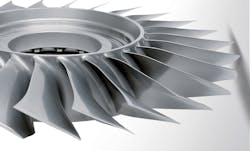Tests Proceeding for 3DP Titanium Turbine Structures
Norsk Titanium and two research partners reported recently that testing is continuing on an integrally bladed rotor (IBR) produced by additive manufacturing. The new research builds on initial testing completed last year and involves examination of the dynamic properties of the IBR. The new goal to develop manufacturing specifications needed to deliver complex, heavily-loaded components for turbomachinery applications, with cost and schedule savings as demonstrated by Norsk with Ti 6-4 airframe components.
“Successful completion of this testing will show that additive materials can be used in turbomachinery applications, and paves the way to a full qualification effort,” stated Norsk chief commercial officer Chet Fuller.
The IBR is a unitized structure of the turbine and blades, in place of a rotor with inserted blades. The design is sometimes preferred in gas turbine engines to reduce part counts and improve assembly and maintenance.
The bladed rotor being studied is produced by Norsk Titanium’s Rapid Plasma Deposition (RPD™ ) technique, a wire-based metal AM process involving titanium wire, argon gas, and a plasma arc. The developer claims the process delivers "forged strength" with lower cost, less machining, lower material consumption, and reduced lead time. It has been used to develop Ti 6-4 aerostructural parts in partnership with Boeing, among other aircraft OEMs and suppliers.
The tests are being conducted at the University of Notre Dame Turbomachinery Laboratory, which is one of the research partners. Also in the project are Pratt & Whitney Corp. and Turbocam International, a Barrington, NH, developer and manufacturer of turbomachinery components.
While the initial testing confirmed that the metal AM-produced IBR met all design, speed, and pressure ratio test points, the current program is studying low- and high-cycle fatigue characteristics of the IBR. The testing will include multiple acceleration/deceleration cycles and investigate synchronous vibration effects on the additively manufactured blades, according to Norsk Ti.
Prior to the new round of testing, a "manufacturing qualities evaluation" performed by Turbocam found no evidence of alpha case or residual-stress concentrations that may cause distortions typically found in additive materials. Turbocam also confirmed that RPD material is well-suited to traditional milling operations, and was as stable as forged Ti6-4 material.
All manufacturing and testing has been overseen by Pratt & Whitney and is being evaluated for application to future engine developments.
“Utilizing additive manufacturing techniques, such as Norsk’s Rapid Plasma Deposition process, allows us to shorten the manufacturing and development schedule for our critical turbomachinery components,” stated Chris Kmetz, vice president of engineering, Module Centers, Pratt & Whitney.
